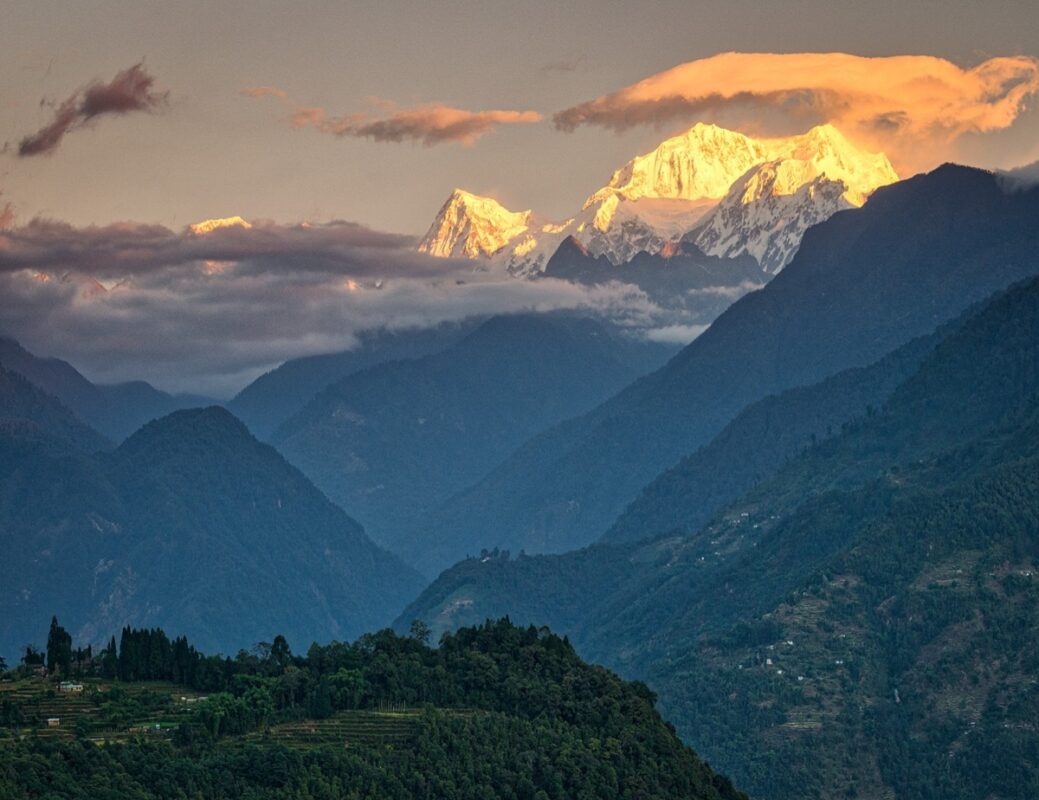Table of Contents
ToggleWhether you seek spiritual solace at ancient monasteries, adventure through rugged mountain trails, or simply wish to bask in the tranquility of pristine lakes and verdant forests and meadows, the North-eastern Himalayan state Sikkim has something for everyone. The state’s varied geography, from snow-capped peaks to lush valleys, weaves together a rich array of experiences that promise to captivate your senses.
In this guide, we explore the top attractions and must-visit places in Sikkim. We will delve into the reasons why these spots are famous, their unique characteristics, and the activities you can enjoy. Additionally, we provide practical information on how to reach these destinations, the cost involved, and accommodation options to help you plan an unforgettable tour to Sikkim, the smallest Himalayan state in India.
1. Gangtok
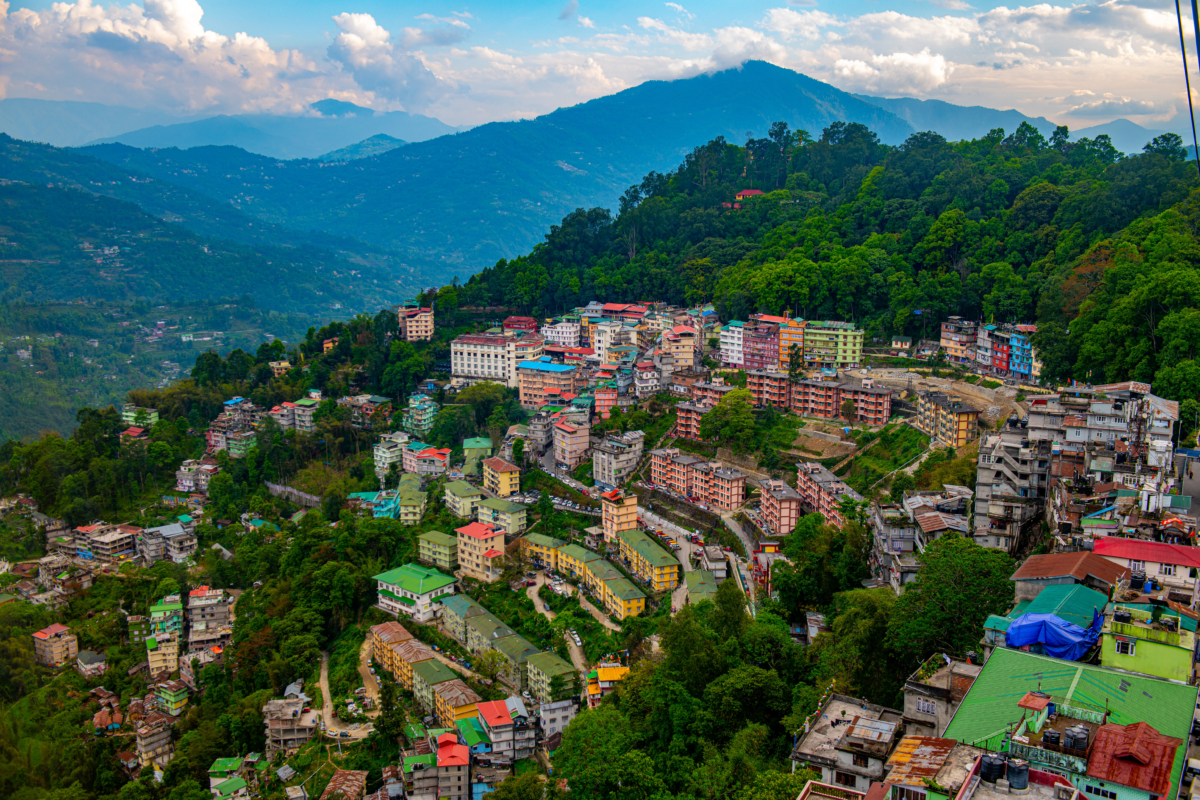
Why Famous?
-
- Renowned for its vibrant culture, bustling markets, and scenic beauty.
- Capital city of Sikkim and central hub for tourism.
Unique Facts:
-
- Home to the Namgyal Institute of Tibetology, which holds one of the largest collections of Tibetan artifacts outside Tibet.
- Hosts the annual Gangtok Carnival, a week-long event showcasing local music, dance, and cuisine.
Geographical Characteristics:
-
- Situated at an elevation of 1,650 meters.
- Offers stunning views of the Himalayan ranges, particularly Mt. Kanchenjunga on clear days.
- Characterized by its terraced hillsides and lush green surroundings.
Attractions and Things to Do:
-
- Gangtok Local Sightseeing Tour:
- Half Day Tour (7 Points):
- MG Marg: Pedestrian-only street, perfect for shopping and dining.
- Enchey Monastery: 200-year-old monastery offering spiritual insights and panoramic views.
- Tashi View Point: Known for sunrise and sunset views over the Kanchenjunga range.
- Ganesh Tok: Temple with stunning viewpoints.
- Hanuman Tok: Another temple known for its scenic views.
- Flower Exhibition Centre: Displays a variety of seasonal flowers and orchids.
- Banjhakri Falls: Beautiful waterfall set in a landscaped park.
- Full Day Tour (10 Points):
- Includes all points from the Half Day Tour plus:
- Namgyal Institute of Tibetology: Museum and research centre dedicated to Tibetan culture.
- Do Drul Chorten: A significant stupa with meditation halls.
- Ranka Monastery: Also known as Lingdum Monastery, a serene and picturesque location.
- Half Day Tour (7 Points):
- Other Sightseeing Spots (Not covered in regular tours but must visit):
- Rumtek Monastery: One of the largest and most significant monasteries in Sikkim.
- Bakthang Waterfall: A lesser-known but beautiful waterfall on the outskirts of Gangtok.
- Saramsa Garden: A picturesque garden known for its diverse flora and a popular picnic spot.
- Terraced Rice fields at the villages around Gangtok like Martam, Nazitam and Sang.
- Gangtok Local Sightseeing Tour:
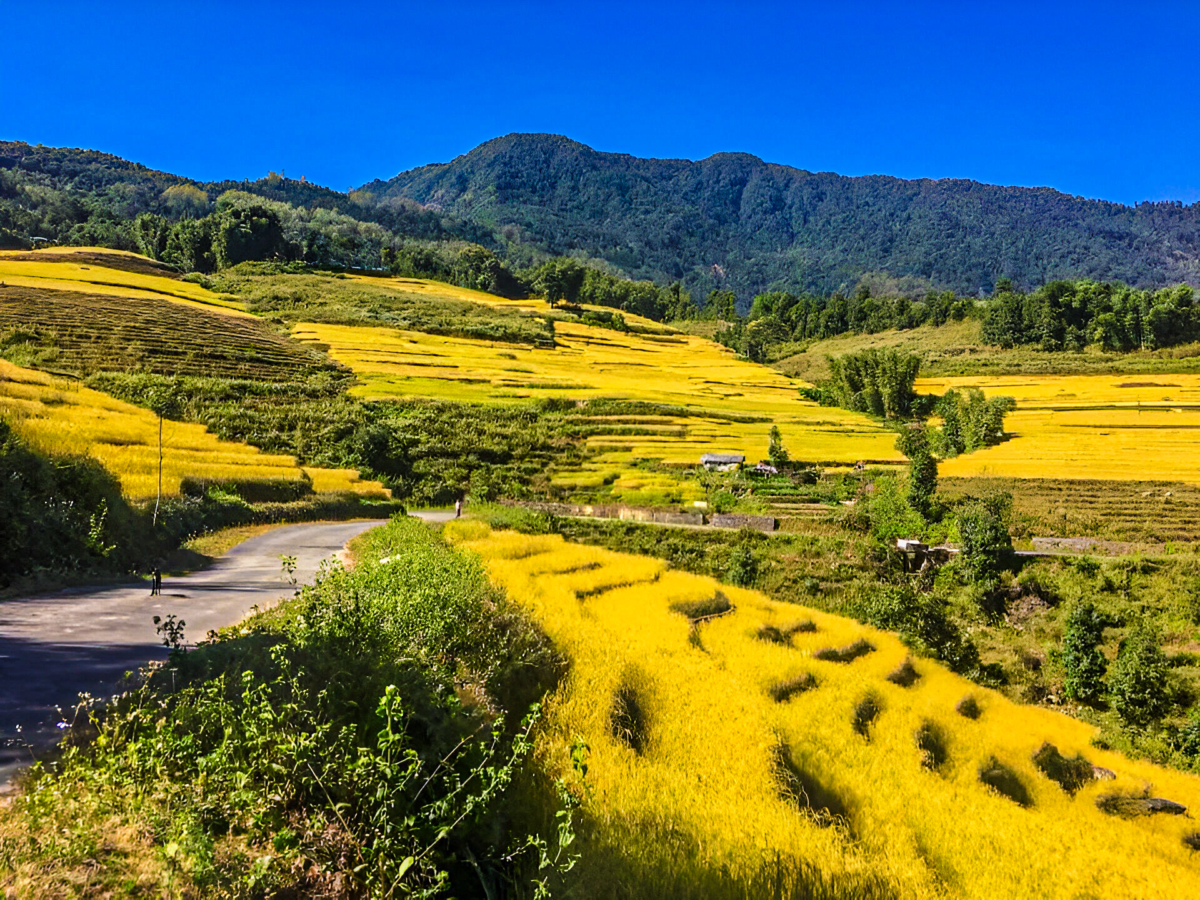
-
- Tsomgo Lake, Baba Mandir, and Nathula Tour:
- Tsomgo Lake: High-altitude glacial lake known for its pristine beauty.
- Baba Mandir: Shrine dedicated to Baba Harbhajan Singh, a revered figure in the region.
- Nathula Pass: Mountain pass at the Indo-China border, offering breathtaking views and historical significance.
- Multi-day Tour to North Sikkim (ex-Gangtok):
- Lachen and Gurudongmar Lake: Scenic village and one of the highest lakes in the world.
- Lachung and Yumthang Valley: Picturesque village and valley known for its meadows and hot springs.
- Zero Point: High-altitude area offering stunning views of snow-capped mountains.
- Tsomgo Lake, Baba Mandir, and Nathula Tour:
How to Reach from Gangtok:
-
- Local taxis and private cars are readily available for sightseeing within Gangtok and nearby areas.
- The city is well-connected by road to other parts of Sikkim and neighboring states.
- Cost:
- Local sightseeing taxi costs range between ₹1,500 to ₹3,000 per day, depending on the number of spots covered and the type of vehicle.
- Tsomgo Lake, Baba Mandir, and Nathula Tour costs around ₹6,000 per vehicle.
- Multi-day North Sikkim tour costs approximately ₹3,000 to ₹5,000 per person per day.
- Permit:
- No special permits required for exploring Gangtok city.
- Permits needed for visiting restricted areas like Tsomgo Lake, Nathula Pass, and North Sikkim. These can be arranged through travel agents or hotels.
- Accommodation and Food:
- Accommodation: Options range from budget hotels (₹1,500/night) to luxury resorts (₹7,000/night). Popular choices include The Elgin Nor-Khill, Mayfair Spa Resort & Casino, and budget options like Hotel Sonam Delek.
- Food: Various dining options including local Sikkimese cuisine, Tibetan dishes, and multi-cuisine restaurants. Popular spots include Taste of Tibet, Cafe Live & Loud, and The Coffee Shop.
- Minimum Days Required:
- To fully enjoy and explore Gangtok, a stay of 2-3 days is recommended. This allows ample time to visit major attractions, enjoy local cuisine, and soak in the scenic beauty.
- Additional 2-3 days are required for Tsomgo Lake, Baba Mandir, and Nathula Tour.
- A minimum of 4-5 days is needed for a comprehensive North Sikkim tour.
2. Lachung
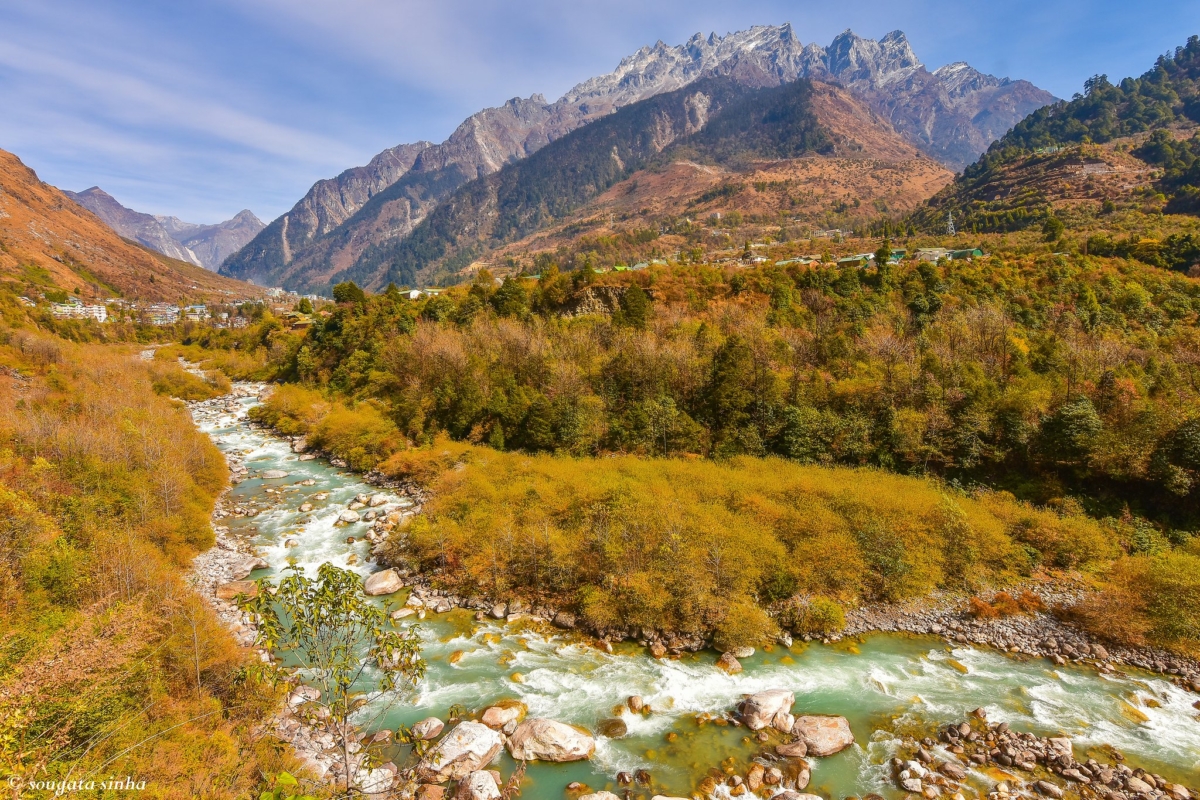
Why Famous?
Lachung is celebrated for its pristine beauty and is often referred to as one of the most picturesque villages in Sikkim. Known as a gateway to the mesmerizing Yumthang Valley, it is also popular for the unique blend of Tibetan and Lepcha cultures.
Unique Facts:
- Lachung is situated near the confluence of the Lachen and Lachung Rivers, which are tributaries of the Teesta.
- Home to the traditional annual Mask Dance Festival at Lachung Monastery, which attracts both locals and tourists.
- During winter, the village transforms into a snow-clad wonderland, making it ideal for winter tourism.
Geographical Characteristics:
- Located at an altitude of 2,700 meters, Lachung is surrounded by lush green hills and snow-capped mountains.
- The area experiences distinct seasons, with vibrant flowers blooming in spring and a snowy landscape in winter.
- The Lachung Chu river runs through the valley, adding to its scenic charm.
Attractions and Things to Do:
- Yumthang Valley: Often called the “Valley of Flowers,” Yumthang is renowned for its spring bloom of rhododendrons and other wildflowers. The valley offers stunning views of snow-capped peaks and lush meadows.
- Hot Springs: Near Yumthang, there are natural hot springs known for their supposed healing properties. The springs are popular for a relaxing dip amidst beautiful natural surroundings.
- Zero Point: Located about 23 km from Yumthang Valley, Zero Point (Yumesamdong) is a high-altitude area where the road ends. It offers an unparalleled view of snow-covered mountains and is a favorite spot for snow enthusiasts.
- Sanglaphu Lake
- Lachung Monastery: Dating back to the 19th century, this monastery is a cultural and religious hub in Lachung. It is particularly vibrant during festivals when locals perform the traditional mask dance.
- Shingba Rhododendron Sanctuary: Known for its extensive variety of rhododendrons, this sanctuary bursts with color from April to June and is a must-visit for nature lovers and botanists.
- Dombang Valley
- Gora La Lake
- Mt. Katao
How to Reach from Gangtok:
- Lachung is approximately 110 km from Gangtok. Private taxis and shared cabs are available for the journey, which takes around 5-6 hours through winding mountain roads.
- The drive to Lachung offers scenic views of waterfalls, forests, and mountains, making the journey itself an attraction.
Cost:
- Transport: A shared taxi from Gangtok to Lachung costs around ₹1,000 to ₹1,500 per person, while private vehicle rentals range from ₹5,000 to ₹7,000 for a round trip.
- Permit: North Sikkim requires a restricted area permit. Travel agents or hotels typically arrange this for a small fee.
- Accommodation: Budget accommodations start from ₹1,500 per night, while mid-range hotels are available for ₹3,000–₹5,000 per night.
Accommodation and Food:
- Lachung offers cozy homestays and comfortable hotels, allowing you to experience local hospitality and culture. Recommended places include The Fortuna Lachung, Le Coxy Resort, and Yarlam Resort.
- Local food options feature traditional Sikkimese and Tibetan cuisine, with dishes like thukpa, momos, and yak cheese specialties. Many accommodations provide in-house dining with home-cooked meals.
Minimum Days Required:
A stay of 2-3 days is ideal for exploring Lachung and its surroundings, giving you ample time to visit Yumthang Valley, Zero Point, and Lachung Monastery, and to unwind amidst the peaceful mountains.
3. Lachen
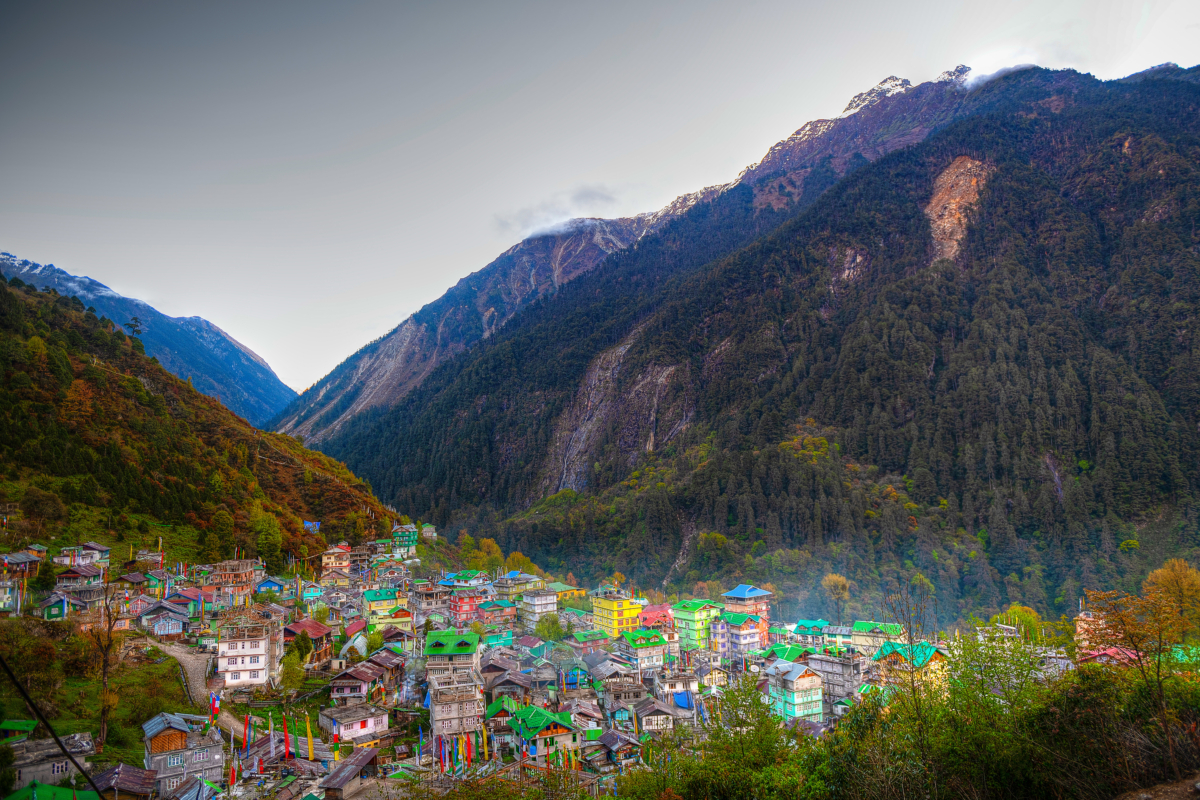
Why Famous?
Lachen is known for its peaceful mountain charm and serves as a base for travelers heading to the stunning high-altitude lake, Gurudongmar. This quaint village offers visitors a unique glimpse into the traditional culture of Sikkim and is an emerging destination for nature and adventure enthusiasts.
Unique Facts:
- Lachen, which means “big pass,” is a significant stop for those visiting the sacred Gurudongmar Lake, one of the world’s highest lakes.
- The village is home to the Lachenpas, a tribal community with distinct customs and traditions.
- Lachen Monastery is a focal point of the community, hosting religious festivals and ceremonies.
Geographical Characteristics:
- Situated at an elevation of approximately 2,750 meters, Lachen is surrounded by pine-covered slopes and panoramic views of the mountains.
- The landscape features alpine pastures and glacial streams, creating a pristine environment that changes dramatically with the seasons.
- Snow blankets Lachen in winter, adding a magical aura, while summer brings lush greenery and blooming flowers.
Attractions and Things to Do:
- Gurudongmar Lake: Situated at 5,430 meters, this sacred lake is revered by both Buddhists and Sikhs. The lake’s partially frozen surface, surrounded by rugged peaks, makes it a breathtaking sight. Due to its altitude, oxygen levels are low, and visitors are advised to prepare for the conditions.
- Chopta Valley: Known for its meadows, rivers, and abundance of wildflowers, Chopta Valley is an excellent spot for trekking, bird watching, and photography. It’s especially scenic during the summer when flowers bloom.
- Lachen Monastery: Also known as the Ngodub Choling Monastery, it stands as a cultural landmark and offers serene views of the valley. Visiting during the annual mask dance festival provides a deeper look into local traditions.
- Thangu Valley: A high-altitude valley just an hour’s drive from Lachen, Thangu is a summer grazing ground for yaks and has a peaceful ambiance. The valley is also a starting point for treks to Muguthang and other offbeat routes.
- Kalapatthar Snow Point: The most popular snow point in Sikkim which guarantees snow even in the summer months. Kalapatthar Snow Point is normally visited in the day trip to Gurudongmar Lake and Chopta Valley.
- Trekking and Adventure Activities: Lachen offers several trails through dense forests and alpine meadows, attracting adventure seekers who want to experience the untouched landscapes around the village.
How to Reach from Gangtok:
- Lachen is about 120 km from Gangtok, and the drive takes 6-7 hours through mountain roads. Shared cabs and private taxis are available from Gangtok.
- The journey to Lachen includes scenic views of rivers, waterfalls, and mountain villages, making the drive a memorable part of the trip.
Cost:
- Transport: Shared taxis from Gangtok to Lachen cost around ₹1,500 per person, while private rentals cost between ₹5,000 and ₹8,000 for a round trip.
- Permit: North Sikkim requires a restricted area permit, which is usually arranged by travel agencies or hotels.
- Accommodation: Budget accommodations in Lachen start from ₹1,500 per night, with more comfortable options priced around ₹3,000–₹5,000 per night.
Accommodation and Food:
- Lachen has a range of cozy homestays and small hotels, such as Apple Orchard Resort, Delight Royal Lachen, and Lachen Deezong.
- Meals here typically include local Sikkimese and Tibetan cuisine, with options like thukpa, momos, and local breads. Dining is often provided by homestays or hotels.
Minimum Days Required:
A 2-3 day stay is recommended for Lachen to allow time for acclimatization, a visit to Gurudongmar Lake, and exploration of nearby attractions like Chopta and Thangu Valleys.
4. Pelling
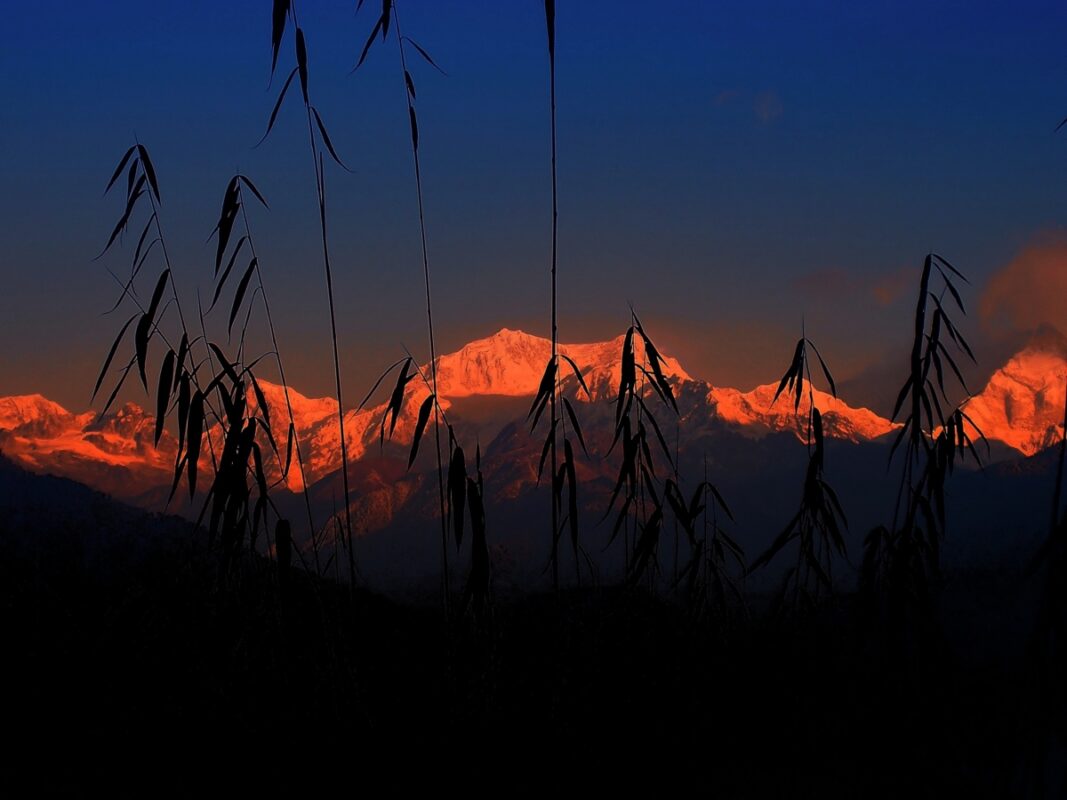
Why Famous?
Pelling is one of Sikkim’s top tourist destinations, known for its breathtaking views of Mt. Kanchenjunga and its rich cultural heritage. It has grown in popularity due to its proximity to several historical sites, monasteries, and scenic landscapes, making it a perfect blend of natural beauty and cultural exploration.
Unique Facts:
- Pelling offers some of the best views of the third-highest peak in the world, Mt. Kanchenjunga, especially at sunrise.
- The town is home to the first glass Skywalk in India, providing a thrilling view of the landscape below and the Kanchenjunga range in the distance.
- Pemayangtse Monastery in Pelling is one of the oldest and most important monasteries in Sikkim, dating back to the 17th century.
Geographical Characteristics:
- Pelling is situated at an altitude of about 2,150 meters and is surrounded by dense forests, waterfalls, and picturesque mountain landscapes.
- The area is known for its terraced hillsides, rich flora, and several water bodies, offering a serene environment ideal for nature lovers.
Attractions and Things to Do:
- Pemayangtse Monastery: This ancient monastery is a significant religious site, home to a remarkable collection of Tibetan artworks, sculptures, and murals. The annual Chaam (Mask Dance) festival is a major attraction here.
- Skywalk and Chenrezig Statue: India’s first glass Skywalk is located in Pelling, leading up to the giant statue of Chenrezig, a revered Buddhist deity. The Skywalk offers a unique experience, providing both thrilling views and spiritual significance.
- Rabdentse Ruins: These are the remains of the former royal capital of Sikkim and hold historical importance. The ruins are located amidst forests and offer panoramic views of the surrounding valley and mountains.
- Khecheopalri Lake: A sacred lake for both Buddhists and Hindus, Khecheopalri Lake is believed to fulfill wishes. Surrounded by dense forests, the lake is incredibly serene, and its still, clear waters are revered as sacred.
- Kanchenjunga Falls: One of the largest waterfalls in Sikkim, the Kanchenjunga Falls cascades from a high altitude, offering a picturesque spot for photography and relaxation.
- Singshore Bridge: At over 100 meters in height, Singshore is one of the highest suspension bridges in Asia. It provides stunning views of the valley below and the surrounding mountains, making it a thrilling experience for visitors.
- Rimbi Waterfall and Rimbi Rock Garden: Located near Pelling, the Rimbi Waterfall is another scenic spot popular among tourists. The nearby Rimbi Rock Garden is ideal for picnics and nature walks along the Rimbi River.
How to Reach from Gangtok:
- Pelling is around 130 km from Gangtok, and the drive takes approximately 5-6 hours. Shared and private taxis are available for this route.
- The road journey to Pelling offers beautiful views of the mountains, rivers, and villages, making the drive enjoyable.
Cost:
- Transport: Shared taxis from Gangtok to Pelling cost approximately ₹800 to ₹1,200 per person, while private rentals range from ₹4,000 to ₹6,000.
- Permit: No special permits are required for Pelling itself, but permits may be needed for specific restricted areas if traveling further.
- Accommodation: Budget accommodations start at ₹1,500 per night, with mid-range and luxury options costing up to ₹6,000 per night.
Accommodation and Food:
- Pelling has a range of accommodations from budget hotels to luxury resorts. Popular options include The Elgin Mount Pandim, Pachu Village Resort, and Hotel Phamrong.
- Local restaurants offer Sikkimese, Tibetan, and Indian cuisines, with dishes like thenthuk, gundruk, and phagshapa being popular.
Minimum Days Required:
A 2-3 day stay in Pelling is ideal to explore major attractions, enjoy local cuisine, and experience the natural beauty.
5. Zuluk
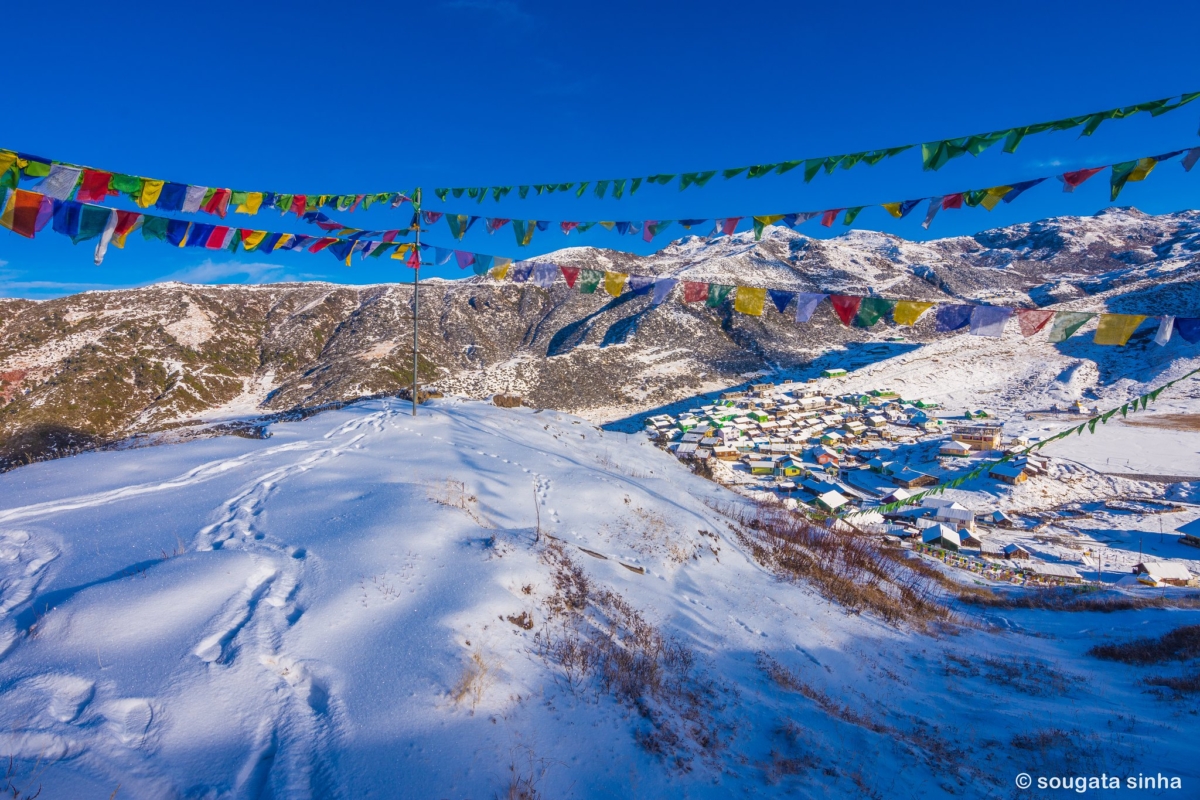
Why Famous?
Zuluk is known for its stunning views of the Eastern Himalayas, especially the panoramic view of the Kanchenjunga range, and its unique zigzag roads. Located along the historic Silk Route, Zuluk offers a blend of natural beauty and historical significance, making it a top destination for those seeking an offbeat experience in Sikkim.
Unique Facts:
- Zuluk is part of the Silk Route that once connected India to Tibet, making it historically significant.
- The area is famous for its 32 hairpin bends, providing an exhilarating experience for travelers and offering one of the most scenic road journeys in the Himalayas.
- Zuluk is popular for its seasonal rhododendron blooms, where entire hillsides are covered in vibrant colors during spring.
Geographical Characteristics:
- Situated at an altitude of about 3,000 meters, Zuluk is surrounded by rugged mountains, terraced valleys, and dense forests.
- The region experiences a range of climates, from snowy winters to misty monsoon seasons, and offers striking landscapes that change with each season.
Attractions and Things to Do:
- Thambi View Point: Known for offering a breathtaking sunrise over the Kanchenjunga range, this viewpoint is also where you can see the famous zigzag roads of Zuluk winding through the mountains.
- Silk Route Zigzag Roads: Driving through Zuluk’s 32 hairpin bends is an adventure in itself, offering a thrilling experience and spectacular views of the Eastern Himalayas.
- Nag Temple: A unique temple located within a cave, dedicated to the serpent deity Nag. It’s a popular religious site and is deeply revered by the locals.
- Kupup Lake (Elephant Lake): Shaped like an elephant, this high-altitude lake is considered sacred and is surrounded by a scenic landscape, making it a popular stop for travelers on the Silk Route.
- Rangli Monastery: A small monastery offering insights into the local culture and Buddhist practices. The monastery is known for its peaceful atmosphere and beautiful architecture.
- Wildlife Spotting: Zuluk is surrounded by forests that are home to Himalayan wildlife such as red pandas, Himalayan monal, and other rare birds, making it a good spot for wildlife and birdwatching enthusiasts.
How to Reach from Gangtok:
- Zuluk is around 90 km from Gangtok, and the drive takes about 4-5 hours via winding mountain roads. Only authorized local taxis are permitted to travel this route due to its sensitive location near the Indo-China border.
- Travelers must arrange for permits in advance, which can be obtained through registered travel agencies or hotels.
Cost:
- Transport: Private taxis from Gangtok to Zuluk generally cost around ₹4,000 to ₹6,000 for a round trip.
- Permit: An Inner Line Permit is required for visiting Zuluk and nearby areas due to its proximity to the border. The permit is generally arranged by hotels or tour operators at an additional cost.
- Accommodation: Homestays in Zuluk typically cost between ₹1,500 and ₹3,000 per night, as the area has limited accommodation options.
Accommodation and Food:
- Zuluk mainly offers basic homestays, providing a cozy and rustic experience. These homestays offer Sikkimese hospitality and local meals, giving visitors a taste of regional dishes such as rice, dal, and momos.
- Due to limited facilities, food options are simple, but visitors can expect homemade meals in a warm, homely setting.
Minimum Days Required:
A 1-2 day stay in Zuluk is sufficient to explore its key attractions and enjoy the scenic drive through the Silk Route’s iconic zigzag roads. This duration allows for acclimatization, especially if traveling to higher elevations nearby.
6. Rinchenpong
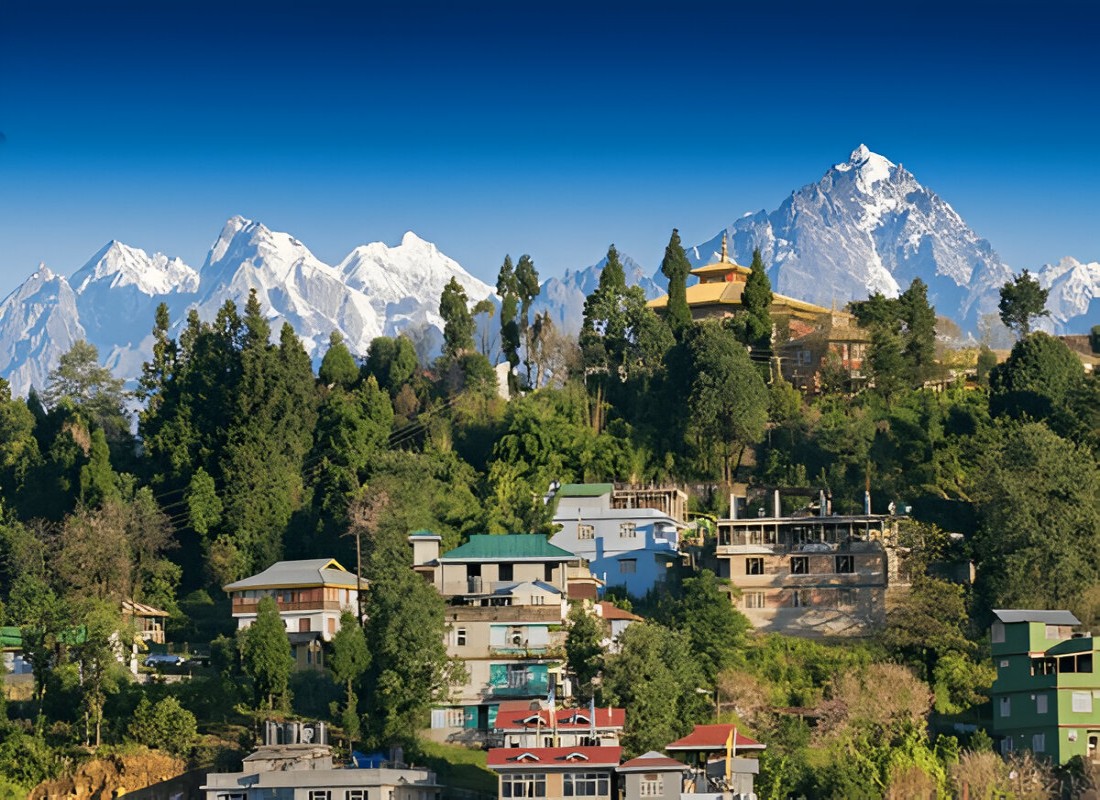
Why Famous?
Rinchenpong, a serene village in West Sikkim, is known for its stunning views of Mt. Kanchenjunga, tranquil environment, and rich history. It’s a perfect destination for those seeking a peaceful retreat and a glimpse into traditional Sikkimese culture.
Unique Facts:
- Rinchenpong houses the historic Poison Lake, named after the local legend that its waters were once poisoned to prevent an enemy invasion.
- It’s also home to the Rinchenpong Monastery, which holds an ancient statue of the Avalokiteshvara (Bodhisattva of Compassion).
- The village offers some of the best sunrise and sunset views over the Kanchenjunga range, making it a favorite among photographers and nature lovers.
Geographical Characteristics:
- Rinchenpong is located at an elevation of about 1,700 meters and is surrounded by lush forests, terraced fields, and charming village landscapes.
- The area is rich in flora, including rhododendrons and orchids, which bloom seasonally, enhancing the village’s natural beauty.
Attractions and Things to Do:
- Rinchenpong Monastery: One of the oldest monasteries in Sikkim, built in the 18th century. It houses rare Buddhist relics and paintings and offers a tranquil space for meditation.
- Poison Lake: A small, mysterious lake surrounded by legends. The peaceful lake is a popular spot for quiet reflection and scenic photos.
- Heritage House: A traditional Sikkimese house showcasing local architecture, artifacts, and historical insights into Sikkimese culture and lifestyle.
- Trekking Trails: Rinchenpong has several scenic trekking routes for both short hikes and full-day treks. Popular trails include the hike to the hilltop for Kanchenjunga views and the trek to Resum Monastery, known for its serene ambiance and panoramic landscapes.
- Traditional Village Walks: Take a guided walk through the village to experience traditional Sikkimese life, interact with locals, and visit organic farms and handicraft centers.
- Birdwatching: Rinchenpong’s forests are home to various bird species, including Himalayan flycatchers, sunbirds, and thrushes, making it a good spot for birdwatching enthusiasts.
How to Reach from Gangtok:
- Rinchenpong is approximately 125 km from Gangtok, and the drive takes about 4-5 hours. Shared and private taxis are available, with the route passing through scenic landscapes and traditional Sikkimese villages.
- Travelers can also reach Rinchenpong from Pelling, which is around 40 km away, offering a shorter and equally scenic journey.
Cost:
- Transport: Shared taxis from Gangtok cost around ₹500 to ₹700 per person, while private taxis range between ₹3,000 to ₹5,000.
- Accommodation: Homestays and budget hotels range from ₹1,200 to ₹3,000 per night, with limited options for higher-end accommodations.
Accommodation and Food:
- Rinchenpong primarily offers homestays and small guesthouses with basic amenities. These stays provide an authentic experience, allowing visitors to enjoy traditional Sikkimese hospitality.
- Meals are often prepared with locally sourced ingredients, including dishes like gundruk (fermented leafy greens) and phagshapa (pork cooked with radishes), along with standard Indian and Tibetan options.
Minimum Days Required:
A 1-2 day stay in Rinchenpong is ideal to explore its main attractions, enjoy leisurely village walks, and relax in the peaceful surroundings. This duration allows ample time to immerse in local culture and take in the picturesque landscapes.
7. Soreng
Why Famous?
Soreng is a quaint town in West Sikkim known for its vibrant horticulture, rich biodiversity, and scenic views of the Kanchenjunga range. Renowned as the “Floriculture Capital of Sikkim,” Soreng is an excellent destination for nature lovers and those interested in rural tourism, offering a mix of beautiful landscapes, cultural experiences, and adventure activities.
Unique Facts:
- Soreng is celebrated for its organic farming, with extensive cultivation of oranges, ginger, cardamom, and orchids.
- It serves as a popular starting point for trekking and camping activities, connecting to nearby attractions like Barsey Rhododendron Sanctuary and Hilley.
- The annual Soreng Tourism Festival, held in December, showcases local culture, traditional dances, handicrafts, and the vibrant flora of the region.
Geographical Characteristics:
- Situated at an altitude of around 1,300 meters, Soreng enjoys a moderate climate and lush green surroundings year-round.
- The town is surrounded by terraced fields, dense forests, and rivers, creating a picturesque setting typical of rural Sikkim.
Attractions and Things to Do:
- Barsey Rhododendron Sanctuary: Located nearby, this sanctuary is famous for its dense rhododendron forests and offers beautiful trekking trails, especially vibrant in spring when the rhododendrons are in full bloom.
- Kaluk: A nearby village known for eco-tourism, Kaluk offers a peaceful environment, homestays, and sweeping views of Kanchenjunga. It’s a great place to experience the region’s unique flora and fauna.
- Rinchenpong Monastery: Though located a bit further, a day trip to Rinchenpong Monastery from Soreng is popular for those seeking spiritual insight and tranquil surroundings.
- Handicraft Shopping and Village Walks: Soreng is known for its traditional handicrafts. Guided village walks provide insight into local lifestyles and allow visitors to purchase handmade items from local artisans.
- Birdwatching and Wildlife Spotting: The region’s forests attract various bird species, including the Himalayan pheasant, making it an ideal destination for birdwatching enthusiasts.
- Trekking and Camping: Soreng is a hub for trekkers, with numerous trails leading to spots like Hilley and even extended treks to Sandakphu. Camping along these trails provides a closer connection to nature.
How to Reach from Gangtok:
- Soreng is around 110 km from Gangtok, and the journey takes approximately 4-5 hours. Private and shared taxis are available from Gangtok to Soreng.
- The town is also accessible from Pelling (approximately 40 km), making it a convenient stop for travelers exploring other parts of West Sikkim.
Cost:
- Transport: Shared taxi costs range from ₹400 to ₹600 per person from Gangtok, while private taxis cost around ₹3,000 to ₹5,000.
- Accommodation: Homestays and budget hotels in Soreng range between ₹1,200 to ₹3,000 per night.
Accommodation and Food:
- Soreng has a range of homestays and small guesthouses, offering comfortable accommodation with a local touch. Many of these stays provide home-cooked meals, including traditional Sikkimese dishes, prepared with fresh, locally sourced ingredients.
- Dining options are limited, so most visitors rely on their homestays for meals, which typically include Sikkimese and Tibetan dishes.
Minimum Days Required:
A stay of 1-2 days in Soreng is ideal for exploring the main attractions, engaging in trekking activities, and experiencing local life. This time allows visitors to take a few short treks, visit nearby attractions, and unwind in the peaceful ambiance.
8. Ravangla
Why Famous?
Ravangla, a charming town in South Sikkim, is known for its serene monasteries, breathtaking views of the Kanchenjunga range, and the stunning Buddha Park. Nestled amidst dense forests and majestic mountains, it has grown into one of Sikkim’s prominent tourist destinations, offering a mix of spirituality, nature, and culture.
Unique Facts:
- Ravangla is home to Buddha Park (Tathagata Tsal), featuring a massive 130-foot statue of Lord Buddha, built to commemorate the 2550th birth anniversary of Buddha.
- The town is an important pilgrimage site, with Ralang Monastery being one of the most revered in Sikkim.
- Ravangla also hosts the Pang Lhabsol festival, which celebrates the consecration of Mt. Kanchenjunga as the guardian deity of Sikkim.
Geographical Characteristics:
- Situated at an elevation of around 2,130 meters, Ravangla provides sweeping views of snow-capped mountains, including Mt. Kanchenjunga, Mt. Pandim, and Mt. Sinialchu.
- Surrounded by verdant forests, colorful rhododendron gardens, and tea plantations, Ravangla’s landscape is a visual treat, especially in spring when the flowers are in full bloom.
Attractions and Things to Do:
- Buddha Park (Tathagata Tsal): A beautifully landscaped park with a towering Buddha statue at its center, Buddha Park is ideal for meditation, leisurely walks, and capturing stunning photos of the surroundings.
- Ralang Monastery: One of the oldest and most important monasteries in Sikkim, Ralang Monastery features traditional Tibetan architecture and houses priceless artifacts and thankas (religious paintings). Visitors can experience the serene Buddhist culture here.
- Maenam Hill Trek: A popular trek that starts from Ravangla, Maenam Hill offers panoramic views of the Eastern Himalayas and is ideal for nature lovers. The trail passes through Maenam Wildlife Sanctuary, where you can spot rare flora and fauna, including the red panda and pheasants.
- Temi Tea Garden: Located near Ravangla, Temi Tea Garden is Sikkim’s only tea estate, famous for producing high-quality organic tea. The scenic tea garden, with its terraced slopes and lush greenery, is an excellent spot for a relaxing visit and tea-tasting experience.
- Samdruptse Hill: A hilltop that houses a massive statue of Guru Padmasambhava, revered by Buddhists as the second Buddha. This site is accessible via a short drive from Ravangla and offers fantastic views and a peaceful atmosphere.
- Hot Springs: The Ralang Hot Springs, located near Ravangla, are known for their healing properties and attract both locals and tourists seeking relaxation and wellness in natural mineral waters.
How to Reach from Gangtok:
- Ravangla is about 65 km from Gangtok, a journey of around 2.5 to 3 hours by road. Shared and private taxis are available from Gangtok.
- It is also accessible from Pelling (50 km) and Namchi (around 25 km), making it easy to incorporate Ravangla into a broader Sikkim itinerary.
Cost:
- Transport: Shared taxis from Gangtok cost around ₹400 to ₹600 per person, while private taxis range between ₹2,000 to ₹4,000.
- Accommodation: A wide range of options is available in Ravangla, from budget homestays (₹1,200 to ₹2,000 per night) to mid-range hotels (₹3,000 to ₹5,000 per night).
Accommodation and Food:
- Ravangla has numerous hotels, guesthouses, and homestays offering comfortable stays with scenic views of the mountains.
- Most accommodations serve local Sikkimese cuisine, Tibetan dishes, and standard Indian fare. Popular local dishes to try include thukpa (noodle soup) and momos (dumplings), often available at homestays and small eateries around town.
Minimum Days Required:
To fully explore Ravangla’s key attractions, a stay of 1-2 days is recommended. This allows time to visit Buddha Park, Ralang Monastery, take a day trek to Maenam Hill, and explore the local surroundings at a relaxed pace.
9. Namchi
Why Famous?
Namchi, meaning “Sky High” in the local language, is the capital of South Sikkim and is celebrated for its scenic viewpoints, religious sites, and cultural significance. Known for the towering statues of Hindu and Buddhist deities, Namchi draws visitors for its peaceful ambiance and rich blend of spirituality, nature, and heritage.
Unique Facts:
- Namchi is home to the towering 108-foot statue of Lord Shiva at Siddhesvara Dham, a popular pilgrimage center that replicates the Chardham temples of India.
- The town also houses a massive statue of Guru Padmasambhava at Samdruptse Hill, symbolizing peace and prosperity.
- Namchi hosts the annual Namchi Mahotsav, showcasing local traditions, food, and handicrafts.
Geographical Characteristics:
- Positioned at an altitude of 1,675 meters, Namchi offers sweeping views of the Kanchenjunga range and the lush valleys of Sikkim.
- The area is characterized by terraced hillsides, green tea gardens, and rhododendron forests, making it a visually appealing destination.
Attractions and Things to Do:
- Siddhesvara Dham (Chardham): This pilgrimage site features replicas of the Chardham temples (Badrinath, Dwarka, Puri, and Rameshwaram) along with a massive statue of Lord Shiva. It is a serene place for prayer and meditation, with expansive views of the surrounding landscape.
- Samdruptse Hill: Known for the colossal 135-foot statue of Guru Padmasambhava, Samdruptse Hill is one of Sikkim’s most revered spots. The hill itself is considered a “wish-fulfilling hill” and offers panoramic views of the Eastern Himalayas.
- Namchi Rock Garden: Situated on the way to Samdruptse, this beautifully landscaped garden features terraced lawns, flower beds, and water bodies. It is an ideal spot for nature lovers and photography enthusiasts.
- Temi Tea Garden: Located about 18 km from Namchi, Temi is Sikkim’s only tea estate and is renowned for its organic tea. The tea gardens, with rolling slopes and pristine surroundings, provide visitors with a peaceful retreat and a chance to sample locally grown tea.
- Tendong Hill: Known for its natural beauty and religious importance, Tendong Hill is popular among trekkers and offers beautiful sunrise views. This hill, traditionally a meditation site for Buddhist monks, is a great day-trip option for those looking to explore beyond Namchi.
- Ngadak Monastery: One of the oldest monasteries in Sikkim, Ngadak Monastery is a tranquil place with a rich history. It is a short drive from Namchi and provides a peaceful spot for meditation and relaxation.
How to Reach from Gangtok:
- Namchi is approximately 78 km from Gangtok, taking around 3 hours by road. Shared and private taxis are available from Gangtok and other nearby towns.
- Namchi is also accessible from Pelling (about 55 km) and Ravangla (around 25 km), making it easy to combine with other South Sikkim destinations.
Cost:
- Transport: Shared taxis from Gangtok cost approximately ₹500 to ₹700 per person, while private taxis range from ₹2,500 to ₹3,500.
- Accommodation: Namchi offers a variety of stays, including budget lodges (₹1,500–₹2,000 per night) and mid-range hotels (₹3,000–₹5,000 per night).
Accommodation and Food:
- Namchi has various accommodation options, ranging from homestays to mid-range hotels with mountain views. Popular options include Cherry Resort near Temi Tea Garden and Hotel Mayal.
- The town offers a mix of Sikkimese, Tibetan, and North Indian cuisine. Local specialties include gundruk (fermented leafy greens) and sel roti, which can be found at local eateries.
Minimum Days Required:
A 1-2 day stay is ideal to fully experience Namchi’s main attractions, allowing time for a leisurely visit to Siddhesvara Dham, Samdruptse Hill, and a scenic drive to Temi Tea Garden.
10. Dzongu
Why Famous?
Dzongu, a reserved area in North Sikkim, is a cultural and ecological haven that is home to the indigenous Lepcha community. Known for its untouched landscapes, traditional homestays, and rich cultural heritage, Dzongu provides a peaceful escape into nature and an authentic glimpse into the Lepcha way of life.
Unique Facts:
- Dzongu is one of the few places in Sikkim where visitors can experience authentic Lepcha culture and lifestyle, as it remains a protected area for the community.
- Known for its diverse flora and fauna, Dzongu is a designated sanctuary that offers opportunities for sustainable tourism, focusing on nature and cultural immersion.
Geographical Characteristics:
- Located in the foothills of the Khangchendzonga range, Dzongu is blessed with pristine rivers, dense forests, terraced paddy fields, and natural hot springs.
- The area is divided into Upper and Lower Dzongu, each with its own unique landscapes and villages that overlook snow-capped peaks, including Mt. Kanchenjunga.
Attractions and Things to Do:
- Cultural Homestays: Staying in a Lepcha homestay is one of the highlights of Dzongu. These homestays provide insights into traditional Lepcha practices, including local crafts, cooking, and music. Visitors can enjoy homemade Sikkimese meals, brewed millet beer (chi), and storytelling sessions.
- Lingthem Village: Known for its panoramic views of the Khangchendzonga range, Lingthem is a quaint village in Upper Dzongu where visitors can take short treks, experience village life, and soak in the scenic beauty.
- Hot Springs (Lingzya and Tholung): The hot springs in Dzongu are popular for their therapeutic qualities. Located near rivers, they offer visitors a natural spa experience amid lush surroundings.
- Tholung Monastery: Accessible through a trek, this monastery is a revered site for the Lepcha people and houses ancient manuscripts and artifacts. The annual Tholung festival is celebrated with unique rituals and draws devotees and tourists alike.
- Kusong Village: Known for its traditional Lepcha houses, Kusong provides a glimpse into Lepcha architecture and is an ideal spot for nature walks and photography.
- Tingvong Village: Another scenic village in Dzongu, Tingvong offers short trekking trails, and visitors can observe local agricultural practices and interact with the villagers to learn more about their customs.
- Birdwatching and Nature Walks: Dzongu is rich in biodiversity, making it a great destination for birdwatching, nature walks, and exploring the lush surroundings. The area is home to many species of orchids, ferns, and butterflies.
How to Reach from Gangtok:
- Dzongu is approximately 70 km from Gangtok, and the journey takes around 3–4 hours by road. Private taxis can be hired from Gangtok.
- Since Dzongu is a protected area, visitors require a permit, which can be arranged through local travel agents or homestay hosts.
Cost:
- Transport: Private taxis from Gangtok to Dzongu cost between ₹3,000 and ₹4,000. Shared taxis are limited but may be available up to Mangan, from where you can find local transport.
- Permit: A permit is required for visitors (₹200-₹300), and this can be obtained through homestays or local agents.
Accommodation and Food:
- Accommodation in Dzongu consists primarily of homestays, which offer basic amenities and are priced around ₹1,500 to ₹2,500 per night, including meals.
- Food in Dzongu is local and organic, featuring dishes like rice, nettle soup, and fermented bamboo shoots, providing a genuine taste of Lepcha cuisine.
Minimum Days Required:
A 2–3 day stay is recommended to experience the culture, nature, and tranquility of Dzongu, allowing time for village exploration, a visit to the hot springs, and a trek to Tholung Monastery if desired.

